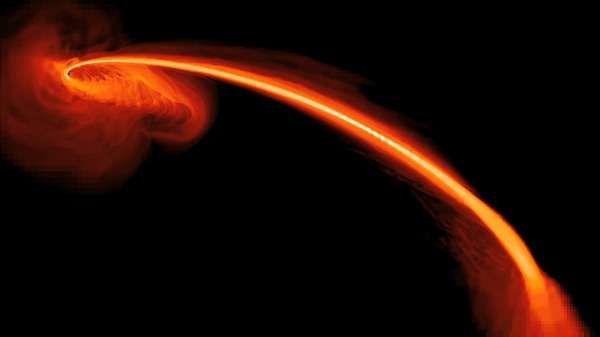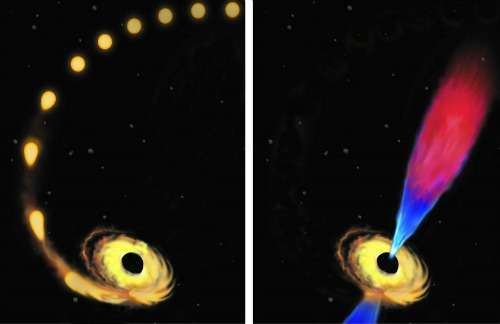Cosmic jets light up black hole's snack

A black hole is often thought of as a giant galactic vacuum cleaner constantly sucking in cosmic material, tearing it apart and swallowing it. So black holes should do exactly the same thing with stars, right?
Wrong!
Just like planets adopt stable orbits around stars millions of times their mass, stars usually attain long-lasting orbits around black holes millions of times as massive.
However on the rare occasion that a star ventures too close, it is drawn into the black hole and destroyed.
"This is something that is quite rare, so we've probably only seen about 20 of them," International Centre for Radio Astronomy Research (ICRAR) astrophysicist Dr Gemma Anderson says.
What is even rarer is the chance to observe a certain black hole—roughly 1 million times the mass of the Sun—gobble up a star but that is exactly what happened recently.
"What's so special about this event is that we've witnessed radio jets coming back out of the black hole," Dr Anderson says.
The discovery is the first time scientists have been able to see both a large disk of material, known as an accretion disk, falling into a black hole and jets coming back out.
What causes the jets is unknown, but whenever a large amount of material forms an accretion disk, theory suggests that jets should be created, shooting material out perpendicular to the disk.
These jets, which are composed of plasma, appear bright in radio telescopes, whereas the accretion disks are bright in x-ray observatories.

The material in the jets can approach 99.9 per cent the speed of light making them the fastest moving celestial objects currently known, and giving them the title of relativistic jets.
The energy produced by the jets in this event is similar to the entire energy output of the Sun over 10 million years, ICRAR astrophysicist Dr James Miller-Jones says.
The discovery was made because this black hole is relatively close to Earth and was studied soon after it was first seen, which was the key, he says.
Usually such events are discovered months or even years after they actually occurred and the jets have disappeared by then.
This black hole is only 300 million light years away from us and the team led by Dr Sjoert van Velzen from Johns Hopkins University was able to make their first observations within a month.
Provided by Science Network WA
This article first appeared on ScienceNetwork Western Australia a science news website based at Scitech.



















